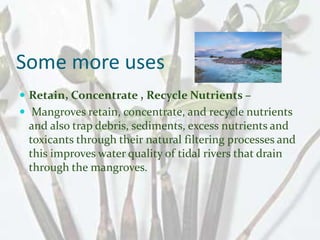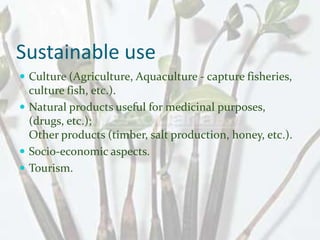Mangroves
- 1. Sudeshna
- 2. Mangroves Mangroves are various kinds of trees up to medium height and shrubs that grow in saline coastal sediment habitats in the tropics and subtropics. With their roots submerged in water, they thrive in hot, muddy, salty conditions. They are extremely important to our own well-being and to the health of the planet. They include a filtration system that keeps out much of the salt.
- 3. Continued Complex root system that holds the plants upright in the shifting sediments where land and water meet is seen in them.
- 4. Uses of mangroves Biological Diversity - They provide food, nesting and nursery areas for many animals which include at least 200 over fish species, 20 reptiles and amphibian species, 15 mammal species and over a 150 bird species. Remove the mangroves and many of these species might be driven to extinction, invariably affecting us as source of food and water and many other ways.
- 5. More uses Environmental Protection – Mangroves protect the coastline by acting as "wave breaks”. They stabilize coastlines and serve as natural barriers/protectors against huge storms, preserving coastlines. They act as wind breaks which reduce the force of winds, lowering the chances of property getting destroyed in wind storms.
- 6. Some more uses Retain, Concentrate , Recycle Nutrients – Mangroves retain, concentrate, and recycle nutrients and also trap debris, sediments, excess nutrients and toxicants through their natural filtering processes and this improves water quality of tidal rivers that drain through the mangroves.
- 7. Uses.. Provide Resources - The mangroves provide us with food and water, medicinal herbs, timber, fuel, and materials.
- 8. Importance of mangroves They are the buffer zone between the land and the sea. Mangroves protect the soil from erosion. They play an invaluable role as a nature’s shield against cyclones, ecological disasters and as protector of shorelines. They are a breeding and nursery grounds for a variety of marine animals.
- 9. Continued Harbor a variety of life forms like invertebrates, fish, amphibians, reptiles, birds and even mammals like tigers. Good source of timber, fuel and fodder. Main source of income generation for shoreline communities like fisher folk. Save the marine diversity, which is fast diminishing. Purify the water by absorbing impurities and harmful heavy metals and help us to breathe a clean air by absorbing pollutants in the air.
- 10. Role of mangroves in tsunami prone areas.. Dense mangrove forests growing along the coasts of tropical and sub-tropical countries can help reduce the devastating impact of tsunamis and coastal storms by absorbing some of the waves’ energy. When the tsunami struck India's southern state of Tamil Nadu on 26 December, for example, areas in Pichavaram and Muthupet with dense mangroves suffered fewer human casualties and less damage to property compared to areas without mangroves.
- 11. Mangroves destroyed due to human activities Despite their critical importance, mangroves are disappearing at an alarming rate around the world. Human development, industrial activity, and aquaculture are rapidly replacing these salt-tolerant trees and the ecosystems they support. In just in the last decade, at least 35 percent of the world's mangroves have been destroyed. That’s a rate of loss that exceeds the disappearance of tropical rainforests.
- 12. Exploitation of mangroves Approximately 35% of mangrove area was lost during the last several decades of the twentieth century (in countries for which sufficient data exist), which encompass about half of the area of mangroves. The united nations environment program also estimated shrimp farming causes a quarter of the destruction of mangrove forests. Likewise, the 2010 update of the World Mangrove Atlas (WMA) indicated a fifth of the world's mangrove ecosystems have been lost since 1980.
- 13. The need to conserve When we destroy the mangroves, not only do we destroy the ecosystems that function naturally, we also lose the free services mangroves provide us with and have to pay to replace them. If the mangroves are destroyed, there will be ecosystem degradation and species endangerment, and loss of wetlands. Declines in fish and wildlife population, floods, problem in water quality will also occur. Thus there arises need to conserve mangroves. Conserve
- 14. Conservation of mangroves Afforestation.(distinct conservation effort) Legislation.(including laws and policies) Monitoring and Surveys.(land and aerial, etc.) Protection.(including conservation, parks and reserves development, etc.) Recommendations. Soil conservation. Status studies.
- 15. Sustainable use Culture (Agriculture, Aquaculture - capture fisheries, culture fish, etc.). Natural products useful for medicinal purposes, (drugs, etc.); Other products (timber, salt production, honey, etc.). Socio-economic aspects. Tourism.
- 16. How to grow mangroves? Mangrove saplings could be easily grown in the nurseries with the locally available seeds/wildlings. Necessary help for raising saplings could be secured from the local forest department or organizations like M.S.Swaminathan Research Foundation, Coastal community Development Agency. Develop mangrove plantations near the existing shrimp farms and near by mangrove areas through planting of mangrove saplings.
- 17. Where to grow mangroves? Plant mangroves where ever they can be grown on the river and sea side of shrimp ponds in the inter-tidal zone. Planting of mangroves in drain canals and effluent treatment ponds could improve the water quality by absorbing nutrients and other organic pollutants. The mangrove plantations along the bunds help in stabilization of banks and prevent soil erosion during floods and reduce sedimentation of ponds during flood.
- 18. Conservation in Andaman and Nicobar islands • In this area, monitoring of mangroves is equally important to study the changes. • Therefore, the use satellite imageries has to be adopted for obtaining authentic area information. • The Forest Department in the islands has completely banned extraction of mangrove fuel wood, and is endeavoring towards conservation of mangroves. • An attempt has been made in this paper to bring out various strategies contemplated for management and conservation of mangroves in the island.
- 19. Conservation in Andhra Pradesh In Southern Coast of Andhra Pradesh, few small patches of mangrove forests occur where-ever mud flats are formed in the backwaters of less important rivers or rivulets. But these forests are mostly out side the control of Forest Department and are degraded and dwindling. The Forest Department has taken up measures for conservation and regeneration for the improvement of Mangrove forests which are under it control. The importance, scope and strategies for improving the mangrove vegetation of the State is described.
- 20. Conservation in Maharashtra and Goa. On August 21-24, the mission visited four sites of the experimental afforestation at the Maharashtra coast. Three government agencies, therefore, assisted the mission, i.e., the NIO at Goa, Forest Department of Goa, and Social Forestry Circle of Maharashtra State. The mission worked under the following terms of reference: 1. Visit to the areas of the mangrove experimental plantations, as well as those that may be put under the same activity. 2. Discussions on matters relating to (a) propagule collection, (b) propagule visibility and equality control(c) propagule storage (d) identification of species suitable for different sites, and (e) establishment of nurseries.
- 21. Thus saving them is important The destruction of mangrove ecosystems is caused mainly because of the conservation benefits of mangroves not receiving importance and the little understanding of the role mangroves play for sustenance of other economic systems. This has led to mangroves being considered as wastelands with little use, and no value. But now assuming their advantages , we should see to it that they are conserved.





















